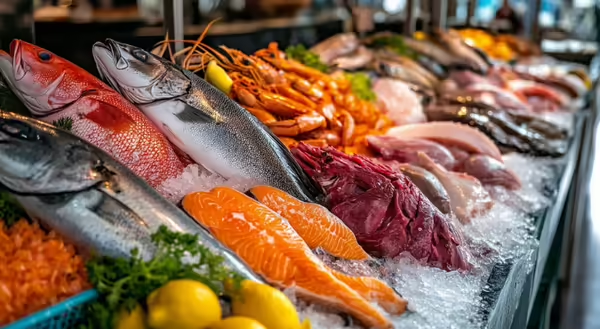
Fish is a great source of protein, omega-3 fatty acids, vitamins, and minerals that can promote health. Fish contain choline, which has been found beneficial in brain development and function. Consider adding more fish to your diet, not forgetting the food safety practices below.
Reduce food safety risks associated with eating fish
Fish can be obtained all year round as raw (frozen or refrigerated), dried, canned, cured, or smoked. The food safety practices outlined below apply mostly to raw fish.
Shopping
- At the point of purchase, select fish displayed or stored under cold temperatures (40 F or below).
- Put fish in an extra bag to prevent juices from spilling on other ready-to-eat food items in your shopping cart.
- If taking more than 2 hours before returning home from shopping, consider using ice or an insulated container to maintain the cold temperature of fish.
Storage
- Maintain the cold chain (40 F or below) until you are ready to cook the fish. You can use a refrigerator or freezer.
- Place the fish in an extra container and store it below fresh produce, cooked foods, and other ready-to-eat foods to prevent the spilling of fish juices into other foods in the refrigerator.
- Store for no longer than indicated on the label to maximize eating quality.
Preparation
- Before preparing fish, wash your hands with clean potable water and soap, and rub hands for 20 seconds. Rinsed hands should be dried with a single-use towel.
- Marinate fish in a refrigerator.
- The knives, cutting boards, and all utensils used during preparation should be washed with clean water and soap, allowing them to air dry before being used to prepare other foods.
- Clean and sanitize the countertops and sinks after preparing fish.
Cooking
- If fish is frozen, you can thaw it in a refrigerator, a microwave, or in cold water. The fish must be cooked immediately if a microwave or cold water is used for thawing. Never thaw at room temperature, like on the countertop.
- Cook fish to a minimum internal temperature of 145 F to destroy pathogens. Use a thermometer to check if the temperature has been reached. Continue cooking until the safe temperature is reached.
- When checking the temperature, place the thermometer in the largest part of the fish.
Handling leftovers
- Leftover fish should be stored within 2 hours of serving, either by refrigerating for not more than 4 days or freezing for 3 to 4 months.
- Reheat leftovers to 165 F before eating them.
Other considerations
Allergens
- If a member of your household is allergic to seafood, place more emphasis on cleaning and sanitizing all surfaces used when preparing and handling fish.
- Consider designating separate utensils for preparing and serving fish.
Heavy metals
- Fish can contain heavy metals such as Mercury, Cadmium, and Lead. Consumption of food containing high levels of heavy metals can negatively impact consumers' health, especially children.
- With many kinds of fish on the market, it may be challenging to know which ones have the lowest levels of heavy metals. Check out this guide to learn more about what kinds of fish are your best choices so that you can eat more of them and which ones to avoid.
- Check with your local Health Department for any fish advisories in your area.
References and resources
Advice about Eating Fish. For Those Who Might Become or Are Pregnant or Breastfeeding and Children Ages 1 - 11 Years, US Food and Drug Administration.
Derbyshire, E., & Obeid, R. (2020). Choline, neurological development and brain function: a systematic review focusing on the first 1000 days. Nutrients, 12(6), 1731.
Khalili Tilami, S., & Sampels, S. (2018). Nutritional value of fish: lipids, proteins, vitamins, and minerals. Reviews in Fisheries Science & Aquaculture, 26(2), 243-253.
Leftovers and Food Safety US Department of Agriculture Food Safety Inspection Service.